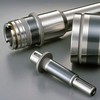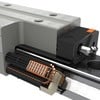Preventing Cage Creep in Roller Bearings
Featured Product from NB Corporation of America
Metal and plastic cages both effectively float between the bearing’s rails and they both tend to drift away from the bearing’s longitudinal center over time, a phenomenon called cage creep. It happens when the linear bearing only makes partial strokes, especially when mounted vertically. The cage can restrict slide travel because once the cage has moved and the bearing makes its next full stroke, the off-center cage hits a rail endstop and is forced to center itself by skidding.
Hitting the endstop and skidding can damage the retainer, rollers, and slideway. And it could require a more powerful and expensive motor to offset the effects of creep. Cage creep also means the rollers are not rolling but slipping and causing metal-to-metal rubbing, which leads to wear.
If a crossed roller bearing has no defense against creep, technicians will often have to regularly readjust the linearmotion equipment and replace worn components. Creep
is particularly bad when applications require high levels of acceleration and deceleration, uneven preloading or load distribution, or vertical or inclined strokes.
Fortunately, there are anti-creep mechanisms that stop retainers from slipping by holding the rollers between the two V-grooved slideway rails. As a result, the rails can be used in any mounting orientation, and lower-momentum motors such as linear motors can be used to move the loads. Anti-creep devices also reduce downtime and the cost of maintenance.
One anti-creep device, a rack-and-pinion mechanism, consists of external plastic gears and a metal gear inside the rail. Though effective, this approach is costly and makes it impossible to change out failed or worn bearing components.
Another approach to preventing creep uses rollers with spherical studs circling the middle of the roller’s round surface. As the rollers turn in the rail, they mesh with a row of holes or dimples machined down the exact center of the raceway tracks. This design, called Studroller at NB, prevents slipping regardless of the rail’s orientation or position. It creates smoother tracking motion than gear-based anti-creep mechanisms, so it is quieter and more accurate. Keeping the rollers aligned along the center of the rail also keeps all components aligned.
With the Studroller approach, the number of effective rollers increases by 20% to 55%. Contact area between rollers and the raceway surface jumps by 42% to 58%, which lets the load rating increase by 140% to 230%. This should lead to savings in cost and space required to mount the linear bearing.
Costs vary for crossed roller bearings with anti-creep devices depending on the complexity of the device whether the application must be custom designed and manufactured to accommodate them. The Studroller approach, being the simplest non-slip design, is priced the same as a standard crossed roller slideway, which is roughly half the cost of other anti-creep devices. And there are no redesign costs to replace a standard slideway.






